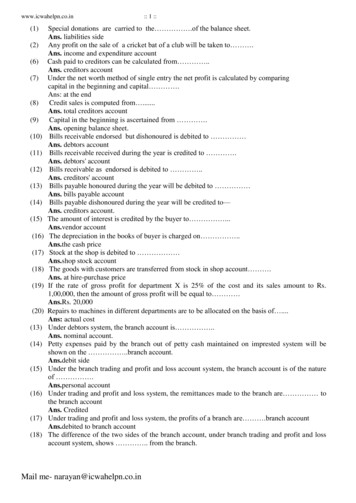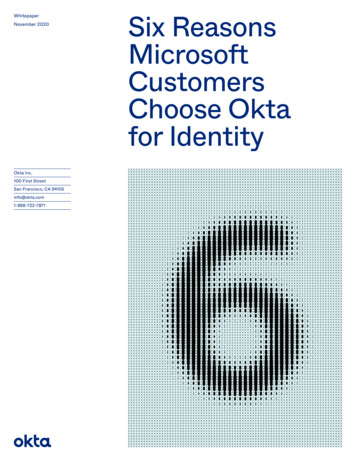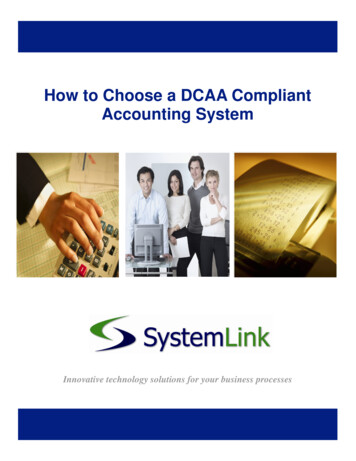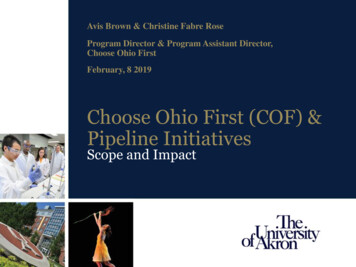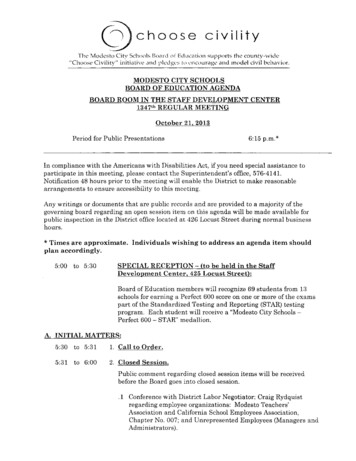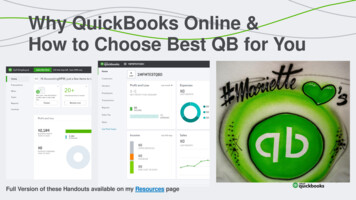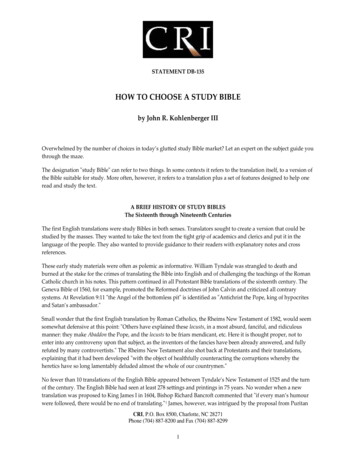
Transcription
STATEMENT DB‐135HOW TO CHOOSE A STUDY BIBLEby John R. Kohlenberger IIIOverwhelmed by the number of choices in today’s glutted study Bible market? Let an expert on the subject guide youthrough the maze.The designation ʺstudy Bibleʺ can refer to two things. In some contexts it refers to the translation itself, to a version ofthe Bible suitable for study. More often, however, it refers to a translation plus a set of features designed to help oneread and study the text.A BRIEF HISTORY OF STUDY BIBLESThe Sixteenth through Nineteenth CenturiesThe first English translations were study Bibles in both senses. Translators sought to create a version that could bestudied by the masses. They wanted to take the text from the tight grip of academics and clerics and put it in thelanguage of the people. They also wanted to provide guidance to their readers with explanatory notes and crossreferences.These early study materials were often as polemic as informative. William Tyndale was strangled to death andburned at the stake for the crimes of translating the Bible into English and of challenging the teachings of the RomanCatholic church in his notes. This pattern continued in all Protestant Bible translations of the sixteenth century. TheGeneva Bible of 1560, for example, promoted the Reformed doctrines of John Calvin and criticized all contrarysystems. At Revelation 9:11 ʺthe Angel of the bottomless pitʺ is identified as ʺAntichrist the Pope, king of hypocritesand Satan’s ambassador.ʺSmall wonder that the first English translation by Roman Catholics, the Rheims New Testament of 1582, would seemsomewhat defensive at this point: ʺOthers have explained these locusts, in a most absurd, fanciful, and ridiculousmanner: they make Abaddon the Pope, and the locusts to be friars mendicant, etc. Here it is thought proper, not toenter into any controversy upon that subject, as the inventors of the fancies have been already answered, and fullyrefuted by many controvertists.ʺ The Rheims New Testament also shot back at Protestants and their translations,explaining that it had been developed ʺwith the object of healthfully counteracting the corruptions whereby theheretics have so long lamentably deluded almost the whole of our countrymen.ʺNo fewer than 10 translations of the English Bible appeared between Tyndale’s New Testament of 1525 and the turnof the century. The English Bible had seen at least 278 settings and printings in 75 years. No wonder when a newtranslation was proposed to King James I in 1604, Bishop Richard Bancroft commented that ʺif every man’s humourwere followed, there would be no end of translating.ʺ 1 James, however, was intrigued by the proposal from PuritanCRI, P.O. Box 8500, Charlotte, NC 28271Phone (704) 887-8200 and Fax (704) 887-82991
John Reynolds, especially because the translation would not have notes. The king detested the notes in the GenevaBible, especially when they commended characters for choosing to obey God rather than human monarchs, as atExodus 1:19. With James’s approval and patronage the work pressed ahead and the new, nonannotated version waspublished in 1611. Though received with mixed reviews, this version soon became so popular that all previoustranslations were eventually put out of print. The version of 1611 began three centuries of its near monopoly as theEnglish Bible.The Twentieth CenturyThe end of the KJV’s monopoly was signaled by the British Revised Version of 1881–85 and the American StandardVersion of 1901. Shortly thereafter, two distinct study systems emerged that would start a new trend in Biblepresentation. Frank Charles Thompson introduced his Marginal Chain‐Reference Bible in 1908 and the following yearsaw the publication of C. I. Scofield’s The Scofield Reference Bible. Thompson provided the model of a study systemthat was doctrinally objective, while Scofield presented a specific system of interpretation in his notes. Most modernstudy Bibles fall into one or the other category established by these pioneering works.The 1970s and early 1980s saw an explosion of English Bible translations. The boom continued in 1995 with theappearance of the New International Reader’s Version, the Contemporary English Version, and God’s Word. The realnoise in the nineties, however, is coming from new study Bibles. Not only are there updated editions of Thompsonand Scofield, there are their modern heirs: objectively oriented systems such as The New Open Bible, and doctrinallyoriented systems such as The Ryrie Study Bible, The Wesley Bible, and The New Geneva Bible.Tyndale House introduced The Life Application Bible in 1987 and with it a significant new trend of needs‐orientedBibles. So strong was the response to Zondervan’s NIV Women’s Devotional Bible in 1990 that it was immediatelyfollowed by NIV Devotional Bibles for men, couples, and seniors. Thomas Nelson’s Serenity: A Companion for 12‐Step Recovery (1990) was matched by Zondervan’s NIV Recovery Bible and Tyndale’s The Life Recovery Bible.Established devotionals or study booklet series were adapted and presented as study Bibles in such works as TheNIV Serendipity Bible for Study Groups (Zondervan, 1989), The International Inductive Study Bible (Harvest, 1992),The Experiencing God Bible (Broadman & Holman, 1993), and The New Daily Walk Bible (Tyndale, 1995).Because the Bible‐buying public seems to have a bottomless appetite for new editions of the Bible, and because Bibletypesetting is a much faster process than ever before, Bible publishers are now issuing new Bibles almost at the pacethat they issue new books. Gone are the days when a Thompson or a Scofield spent decades developing studysystems. Bibles are now being created to catch trends or to associate with the name of a major personality, such asMax Lucado’s Inspirational Study Bible (Word, 1995) or the forthcoming Promise‐Keeper’s Bible.One could be cynical and critical of the Christian publishing industry for such ʺfelt‐needsʺ Bible publishing. Suchproducts, however, are indeed meeting needs. Craig Featherstone, director of marketing for Thomas Nelson Bibles,uses the model of the Sunday school: as there are different class options for different age groups, different needs, anddifferent interests, so there are different study Bibles.This historical overview may help explain the incredible proliferation of study Bibles. But it does not explain how toevaluate a particular edition for personal use. To provide guidance in this regard, this article will first survey therange of features that can be found in a study Bible, and then examine specific features of several classic and recenteditions. Finally, the article will provide a list of questions one can ask to narrow one’s choices to the best possiblevolume.A Survey of Major FeaturesCRI, P.O. Box 8500, Charlotte, NC 28271Phone (704) 887-8200 and Fax (704) 887-82992
In the following survey, features that provide explanations are labeled ʺsubjectiveʺ because the explanation is subjectto the interpreter’s point of view. Features that direct one into and within the text are labeled ʺobjectiveʺ because theyallow the text to speak for itself.Of course, there can be objectivity in interpretation and subjectivity in the selection of texts. Still, I believe this broadcategorization is useful to differentiate between study systems that instruct one what to believe and those that takeone to the text so one can make up one’s own mind. A study Bible that is primarily objective in its features can beused by anyone, regardless of theological affiliation. On the other hand, a study Bible that is primarily subjective ismost useful to someone who agrees with the interpreter — and can even be offensive to someone who does not.The Translation ProperThe single most important feature of a study Bible is its text — its translation — because the most important activityin studying the Bible is reading it. In the nineties, all the best‐selling translations have a wide variety of study systems,sizes, and bindings, although not every study system is available in a variety of translations.Introductions and OutlinesIntroductions usually inform one as to the author, readers, date, origin, and content of a book or section of the Bible;outlines display the contents of a book. Introductions and outlines differ in thoroughness and length, butintroductions can also differ in perspective.Those written by conservative scholars take the Bible’s self‐witness at face value. They agree that Moses wrote all ormost of the Pentateuch (the first five books of the Bible), that Paul wrote 1 and 2 Timothy and Titus, and that Peterwrote 2 Peter because the books themselves say so. Most nonconservative or liberal scholars, however, use criteriaother than the text of the Bible to evaluate its statements and claims. Thus, most liberal scholars believe that a seriesof editors wrote the Pentateuch, that a disciple or disciples of Paul wrote the Pastoral Epistles, and that 2 Peter waswritten a good half‐century after Peter’s death. As a result, the introductions might be the first place to check todiscern whether a study Bible takes a conservative or liberal interpretive perspective.Cross‐ReferencesOne of the most useful features of a study Bible for analyzing the biblical text is its reference system. Cross‐referenceslink verses and passages on the basis of similar words, phrases, and concepts. Cross‐references are usually found in acolumn beside the text, as in The Harper Study Bible; between two columns of text, as in The NIV Study Bible; or inthe notes, as in The Companion Bible. The most specific reference system is in the Thompson Chain‐Reference Bible,which identifies the topic that is referenced, keys it to a numbered topical index, and sends the reader to the nextverse in its chain of references.NotesMuch of the time, notes simply illuminate the text with definitions of obscure or meaningful words, explanations ofcustoms, cross‐references to similar passages, enlightenment from historical background, and similar objectiveinformation. As in the case of introductions, the notes often betray an alignment with a particular theological orcritical approach to the text.CRI, P.O. Box 8500, Charlotte, NC 28271Phone (704) 887-8200 and Fax (704) 887-82993
The notes of the New Jerusalem and New American Bibles, for example, are noticeably Catholic in certain texts.Scofield and Ryrie are both conservative and dispensational. The New Oxford Annotated Bible and TheHarperCollins Study Bible take a liberal/critical approach. Dake is pentecostal.These theological positions can determine the tone and volume of the notes. The Catholic study Bibles tend toemphasize the historical dogmas of the church at key texts such as Matthew 16:17‐19. Scofield and Ryrie emphasizedistinctions between Israel and the church and literal fulfillment of prophecy (e.g., Acts 15:15‐17). The New GenevaBible takes a nondispensational ap‐proach at these texts. Notes in liberal study Bibles often counter the literalunderstanding of the text (e.g., Josh. 10:11) and point out stories and events they feel are contradictory or fabricated(e.g., Judg. 1; 1 Chron. 21). Pentecostal and charismatic writers give extra attention to texts dealing with healing andspiritual gifts (e.g., Matt. 8:17; Acts 2).Concordance and IndexAs the cross reference system connects key words, phrases, and concepts through the biblical text, the index orconcordance lists such connections in a section separate from the text. In function, an index and concordance areabout the same. A concordance, however, is more specific in that it deals only with specific words, while an index candeal both with specific words and with general subjects and concepts.DictionaryA Bible dictionary, like an English dictionary, defines key technical words of the text. Like an encyclopedia, however,it goes beyond definition to give explanatory articles about Bible people, places, events, and subjects. Its informationis drawn primarily from the biblical text and is often supplemented by historical, archaeological, and other biblicalreference works.MapsJust about every Bible in print has a set of maps bound into it. More recent editions, such as the NIV Study Bible andThe Word in Life Study Bible, have dozens of in‐text maps detailing locations and movements in the biblicalnarrative. Many sets of maps are indexed so that countries, cities, and natural landmarks can be easily located.Charts and Other IllustrationsCharts gather and display biblical and historical data in a more visual form. The Thompson Chain‐Reference Biblewas one of the first to make extensive use of charts in outlining biblical history, character studies, and topicalinformation. The New Open Bible and The Word in Life Study Bible use charts to diagram and summarize thecontents of each book of the Bible. The NIV Study Bible has three dozen charts that gather biblical materials andintegrate them with historical and cultural information.Special Essays and ArticlesMost study Bibles have special articles on such subjects as how to understand the Bible, outlines of biblical historyand archaeology, theological themes, the history of Bible translation, and so on. One can almost evaluate the articlesin a study Bible by its table of contents. The titles and number of pages alone may reveal how useful they are andhow often one might consult them. Some are so brief or general that one may read them only once or never at all.CRI, P.O. Box 8500, Charlotte, NC 28271Phone (704) 887-8200 and Fax (704) 887-82994
Harmony of the Gospels and Old Testament HistoryMany study Bibles organize the events of the Gospels into a roughly chronological outline, showing both the parallelsand unique accounts of each. This parallel outline is called a harmony, usually presented in the subheads of thebiblical text or as a separate feature. Some more recent study Bibles, such as The NIV Study Bible, do the same for OTparallels.A SURVEY MAJOR STUDY BIBLES2Objectively Oriented Study BiblesDickson New Analytical Study Bible (World, 1931; [9th] Revised Edition, 1973) KJVThe Dickson New Analytical Study Bible has about 800 pages of well‐designed helps. A general introduction to theBible and a 184‐page Bible dictionary precede the text. Each book has an introduction and an analytical chart,followed by a discussion of that book’s outstanding facts. The volume concludes with, among other features, a 42‐page topical Bible and a 117‐page concordance. A 17,000‐entry general index ties together all of these features.New Open Bible (Nelson, 1975; Expanded Edition, 1990) KJV, NASB, NKJVThe major features of the New Open Bible are its ʺBiblical Cyclopedia Indexʺ (a 300‐page topical Bible/concordance),lengthy book introductions and outlines, ʺChristian Life Study Outlinesʺ in the NT, and concordance. Alternatetranslations and cross references are given at the end of each verse, though the space limitations of this format resultin a rather small reference system. Other features include an outline harmony of the Gospels and articles on biblicalbackgrounds. Expanded editions in 1983, 1985, and 1990 have lengthened book introductions with analytical charts toillustrate their outlines, a 24‐page ʺVisual Survey of the Bible,ʺ and 40 pages of key word studies. Because of itsvariety of features and its availability in three major translations, the New Open Bible is very popular amongevangelicals.Thompson Chain‐Reference Bible (Kirkbride, 1908; 5th Improved Edition, 1988) KJV, NIV, NASB, NKJVThe heart of this work is its unique chain‐reference system. Thompson developed a ʺChain Indexʺ of more than 4,000biblical subjects that forms a 196‐page ʺTopical Bible and Dictionaryʺ (KJV edition) immediately following the biblicaltext. Then, rather than simply sprinkling the margins with cross‐references, he lists the specific topics in each versewith their index number, and often identifies the next biblical reference in the chain. By turning to the numberedtopic in the back or following the references through the text, one is led in a well‐organized thematic study.This Bible also contains more than 50 additional features in its eight ʺdepartments,ʺ including introductions andoutlines of each book, character studies, dozens of historical and topical charts and diagrams, an archaeologicaldictionary, and a concordance, all of which are keyed by number to the text and index. Because of its valuablereference system and its availability in four of the top five translations, the Thompson Chain‐Reference Bible remainsa popular choice.Subjectively Oriented Study Bibles—Conservative:DispensationalCompanion Bible (1910; Kregel reprint, 1990) KJVOriginally published in six volumes, this massive work of more than 2,150 pages contains reams of valuable, thoughsometimes eccentric, study helps. Each book is introduced and outlined, but each section and paragraph is alsooutlined in further detail in the notes that parallel the text. The notes themselves contain explanatory, topical,CRI, P.O. Box 8500, Charlotte, NC 28271Phone (704) 887-8200 and Fax (704) 887-82995
linguistic, and historical insights and are keyed to detailed studies in the 198 appendices that follow the text. Thewriter, E. W. Bullinger, is known for his ultradispensational teaching in other writings, but in the Companion Biblehis dispensationalism is limited to the book introductions and appendices and is hardly more radical than Scofield orRyrie.Ryrie Study Bible (Moody, 1976 [NT], 1978; Expanded Edition, 1994) KJV, NASB, NIVThe Ryrie Study Bible can be characterized as the Scofield Reference Bible for the end of the twentieth century.Though Ryrie is an advocate of dispensationalism like Scofield, he does not promote it as emphatically. Notes containexplanatory, historical, and cultural information as well as doctrinal insights. The expanded editions of 1994incorporated additional notes and many in‐text graphics and maps to the classic text. Unique to this study Bible is its22‐page ʺSynopsis of Bible Doctrine,ʺ which outlines major elements of theology and lists the interpretations ofseveral major systems at each point. Available in three of the top five translations, the Ryrie Study Bible has a strongfollowing among evangelicals.Scofield Reference Bible (Oxford, 1909, 1917) and New Scofield Reference Bible (Oxford, 1967) KJV, NIV, NASB,NKJVPerhaps no study Bible has been so widely used or so strongly criticized as the Scofield Reference Bible. Its wide useresults from its excellent organization, its high view of the inspiration and unity of Scripture, and its interpretivescheme. The interpretive scheme, dispensationalism, has also generated most of its criticism. Critics ofdispensationalism feel it cuts the Bible into too many pieces, teaches different ways of salvation, and wrongly expectsa literal future fulfillment of prophecies relating to Israel. Nonetheless, Scofield retains a strong following amongconservative evangelicals.Conservative: EvangelicalDisciple’s Study Bible (Broadman & Holman, 1988) NIVThe notes and essays of this study edition are exclusively theological, developing 27 major doctrines (e.g., God,salvation, Christian ethics) throughout the notes. Essays summarize the history of doctrines, with bibliographies forfurther study and an index to all the notes, and offer practical ʺLife Helps.ʺ Among the doctrinally oriented StudyBibles, the Disciple’s Study Bible is one of the most thorough.Harper Study Bible (Zondervan, 1964; revised 1985, 1991) NASB, NRSVHarold Lindsell edited the original RSV edition in 1964 and the NASB in 1985; the NRSV edition was edited byVerlyn Verbrugge. Book introductions precede the text, as do general outlines which are expanded in detail in thetext itself. References are in a single side column, and explanatory, historical, and theological comments are in notesat the bottom of the page. These notes are indexed by subject. One of the few evangelical study Bibles currentlyavailable in the NRSV, the Harper Study Bible remains a useful resource.Hebrew‐Greek Key Study Bible (AMG/Baker, 1984) KJV, NASBSpiros Zodhiates’s Hebrew‐Greek Key Study Bible attempts to communicate insights from the original languages tothe English reader. Several key words in each verse are underlined and footnoted according to Strong’s numberingsystem. Strong’s Hebrew and Greek dictionaries are reproduced in the back of the Bible. Zodhiates has also includedthree major features of his own. First, 170 pages of similarly numbered ʺLexical Aidsʺ expand on Strong’s definitionsof key words. Second, he has noted key aspects of Greek grammar with a system of abbreviations. Third, he hasprovided explanatory notes for difficult and important passages. The NIV edition planned for 1996 will contain amore up‐to‐date analysis of the NIV and the original languages and completely new dictionaries.CRI, P.O. Box 8500, Charlotte, NC 28271Phone (704) 887-8200 and Fax (704) 887-82996
Life Application Bible (Tyndale, 1987, 1993) KJV, LB, NIV, NKJV, NRSVIn addition to its application emphasis, this trend‐setting volume has much explanatory and historical information inits introductions, charts, maps, and character studies, and thus should not be overlooked as a research‐oriented studyBible. Its materials were generated by Youth for Christ under the general editorship of Bruce B. Barton, with morethan a dozen theological reviewers from well‐known evangelical institutions. Because of its practical features and itsavailability in five of the top ten translations, the Life Application Bible is currently one of the best‐selling studyBibles on the market.New Student Bible (Zondervan, 1986, 1992) KJV, NIV, NRSVOriginally intended for youth, this easy‐to‐use study edition has been purchased by millions of adults for their ownuse. Designed by Philip Yancey and Tim Stafford to provide easy access and useful insights to beginning readers, theNew Student Bible starts with a ʺ3‐Track Plan for Reading the Bible.ʺ Track one introduces the Bible with two‐week,one‐chapter‐a‐day reading guides to the Life of Jesus, the life of Paul, and the Old Testament. Track 2 samples everybook of the Bible, 186 chapters in six months. Track 3 is a three‐year, whole Bible reading schedule. Introductionsattempt to capture the essence of each book in contemporary terms and images. Almost every page of the text has atleast one boxed explanatory comment or life‐related insight to give meaning and momentum to daily Bible reading.These materials are indexed in a 30‐page Subject Guide at the end of the book.NIV Study Bible (Zondervan, 1985, 1995) NIVThe NIV Study Bible, as the name implies, was created specifically for this version. Edited by Kenneth L. Barker, its44 contributors (37 of whom were NIV translators) represent a wide denominational spectrum of internationalevangelicalism. A unique feature of this Bible is that the contributors represent no exclusive theological alignment.The notes often present more than one possible understanding. An example is Revelation 20:2, where three majorperspectives on the millennium are summarized, as opposed to Ryrie and Scofield, which are exclusivelypremillennial. The 1995 revision enhanced the readability and graphics and added some notes. The Concordia Self‐Study Bible (Concordia, 1986) is a specialized edition with additional materials from a conservative Lutheranperspective. Because of the thoroughness and quality of its features, the NIV Study Bible has sold nearly three millioncopies and is this writer’s preferred choice.The Quest Study Bible (Zondervan, 1994) NIVChristianity Today provided the materials for this unique study Bible. Its notes are in a question‐answer format. Thequestions were drawn from a survey of more than 1,000 people; the answers were provided by more than 100contributors under the editorship of Marshall Shelley. These notes are also indexed by subject. Key biblical andtheological terms, like grace, parable, and soul are flagged with a raised D to indicate they are defined in the concisedictionary. The Quest Study Bible can be recommended to and used by Christians as well as seekers.Word in Life Study Bible ([NT] Nelson, 1993) NKJV, NRSVThis seeks to be a ʺuser‐friendlyʺ study Bible with its extensive use of boxed and shaded graphics, articles, maps, andline drawings in a two‐color presentation. Its study features and the biblical text are both indexed for more systematicstudy. The quantity of its features and its generous type size are underlined by the fact that the NT alone fills morethan 1,000 pages.Conservative: Pentecostal / CharismaticDake’s Annotated Reference Bible (Dake, 1961 [NT], 1963) KJVCRI, P.O. Box 8500, Charlotte, NC 28271Phone (704) 887-8200 and Fax (704) 887-82997
Dake’s is the product of 43 years of study and is one of the few study Bibles that has more words in its helps than inthe Bible. Most of Finis Jennings Dake’s materials are set in two columns that appear on each page beside the twocolumns of biblical text. His introduction claims 500,000 cross‐references, 35,000 notes and comments, 8,000 outlines,and 2,000 illustrations. Many of these materials are lists of observations from the text, but much is interpretive, withemphasis on prophecy, healing, and the miraculous.This work contains a great deal that is speculative and unorthodox, such as Dake’s belief in God’s ʺspirit bodyʺ withʺbodily partsʺ that ʺgoes from place to placeʺ (pp. 96‐97 [NT]), his strong teaching on racial segregation (e.g., pp. 148[OT] and 159 [NT]), and his dogmatism on just about every subject he addresses. The Dake’s study Bible cannot berecommended to journal readers, charismatic or not.Full Life Study Bible (Zondervan, 1992) KJV, NIVPrimarily the work of Donald C. Stamps and J. Wesley Adams, with nine editorial advisors, this study Biblerepresents the mainstream of modern charismatic theology. A system of icons in the margins highlights themes ofinterest, such as the baptism of the Holy Spirit, gifts, healing, and faith that moves mountains. Seventy‐three essaysexpand on key concepts as well as the editors’ personal emphases. For example, three of the essays argue stronglythat all positive references to wine in the Bible refer to unfermented grape juice and that all Christians are required toabstain from alcohol. The Full Life Study Bible is the most moderate of the charismatic study Bibles and can berecommended to journal readers.Spirit‐Filled Life Bible (Nelson, 1991) KJV, NKJVThe Spirit‐Filled Life Bible is the product of 67 contributors, many of them high‐profile pastors such as Jack Hayford(general editor), Frederick Price, and Oral Roberts. In addition to book introductions and textual notes, ʺKingdomDynamicsʺ discuss 22 major topics — such as evangelism, seed faith, prosperity, gifts, and healing — at 350 texts.ʺWord Wealthʺ studies offer 550 brief Greek and Hebrew word studies, indexed to Strong’s numbering system.ʺTruth in Actionʺ sections stress personal application at the end of each book. The notes and topical studies showboth continuities and contrasts within charismatic theology. At Malachi 3:8‐12, for example, the cautious notes byJohn Louwerse contrast to the Kingdom Dynamics by Frederick Price, who states that if one does not tithe properlyone is robbing God, and the ʺlaw of God cannot work on your behalf.ʺ The reader is thus cautioned that this studyBible contains both moderate charismatic theology and more extreme ʺword‐of‐faithʺ elements.The Word Study Bible (Harrison House, 1990) KJVThe Word Study Bible is a two‐column, red‐letter text edition of the KJV with a reference system of 12 topics ofprimary interest to the charismatic movement. Relevant verses are identified with a symbol, but have no furtherexplanation. All references are listed in a topical concordance. Each topic is summarized in an eight‐page article by awell‐known author, such as Kenneth Hagin on faith, Kenneth Copeland on prosperity, and Marilyn Hickey onvictorious living. Because this work represents the ʺhealth and wealthʺ or ʺword‐ of‐faithʺ perspective of thecharismatic movement, it cannot be recommended to journal readers.3Conservative: ReformedNew Geneva Study Bible (Nelson, 1994) NKJVConsciously titled after the influential, Calvinistic Geneva Bible, this work is subtitled ʺBringing the Light of theReformation to Scripture.ʺ Fifty‐five scholars under general editor R. C. Sproul contributed to its contents. Itsinformative notes are supplemented by nearly 100 theological essays, 61 maps, and 47 charts. Its theologicalorientation is Reformed and Calvinistic, but its materials recognize a range of understanding within that tradition.The introduction to Revelation, for example, summarizes the three major millennial perspectives without stating thatCRI, P.O. Box 8500, Charlotte, NC 28271Phone (704) 887-8200 and Fax (704) 887-82998
any one position is the Reformed position. This new volume should be well received and widely circulated within theReformed community.Conservative: Wesleyan / HolinessThe Wesley Bible (Nelson, 1990) NKJVThis work is the modern heir to John Wesley’s Explanatory Notes upon the New Testament (1755) and claims to bethe only study Bible written from a Wesleyan‐Arminian perspective since Wesley’s Notes. Annotations providegeneral explanations, promote Wesleyan theology, and emphasize holy living. Fifty‐five ʺFocus Notesʺ expand onvarious topics, such as ʺTwo Kinds of Sinʺ and ʺThe Terminology of Entire Sanctification.ʺ Forty‐seven maps, 51charts, 16 essays, and a concordance round out the major features of this volume.Nonconservative: Mainline ProtestantBecause the following resources do not approach the biblical text from a conservative or orthodox perspective, theycannot be recommended to journal readers as a primary study Bible. They are included in this article for the sake ofthoroughness.Cambridge Annotated Study Bible (Cambridge, 1993) NRSVThe Cambridge Annotated Study Bi
Max Lucado’s Inspirational Study Bible (Word, 1995) or the forthcoming Promise‐Keeper’s Bible. One could be cynical and critical of the Christian publishing industry for such ʺfelt‐needsʺ Bible publ

